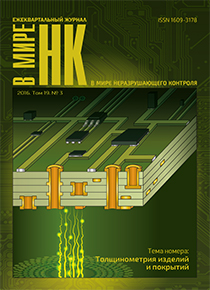Application of fluorescent magnetic suspensions for magnetic particle examination increases process productivity because it eliminates the need to apply (and subsequently remove) priming paint for contrasting white background creating on the tested surface. To obtain contrast fluorescent indications it is necessary to ensure sufficient darkness for the working area. However it is practically impossible to provide the necessary darkness while testing large-size welded and cast products in the industrial premises. The aim of this work was to develop oil-based fluorescent suspension with fluorescence indications of a high level and minimal increase of background fluorescence. As a result the suspension MR®761F has been developed; its fluorescence parameters are several times better than those of the standard product. In addition to high-contrast indications, the new suspension has a high flash point of dispersive medium (83°C); that allows not only reducing the risks of dispersive medium vapour flash from ignition sources (including sparks), but also reducing the amount of hydrocarbon products evaporation in the working area. Besides, the new suspension provides an opportunity to the companies, which were forced to work with far more dangerous radiation sources (450...460 nm), to work with UV radiation of less energy.
magnetic particle examination, personnel safety, hazard of test materials
1. EN ISO 3059: 2013. Non-destructive testing. Penetrant testing and magnetic particle testing. Viewing conditions.
2. GOST R ISO 9934-1:2011. Kontrol´ nerazrushayushchiy. Magnitoporoshkovyy metod. Chast´ 1. Osnovnye trebovaniya [Non-destructive testing - Magnetic particle testing - Part 1: General principles]. Moscow, Standartinform, 2013, 16 p. (in Russ.).
3. GOST R ISO 9934-1:2011. Kontrol´ nerazrushayushchiy. Magnitoporoshkovyy metod. Chast´ 1. [Non-destructive testing - Defektoskopicheskie materialy - Part 2: Detection media]. Moscow, Standartinform, 2013, 20 p. (in Russ.).





